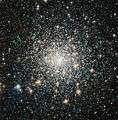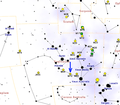Messier 70
Messier 70 or M70, also known as NGC 6681, is a globular cluster of stars in the southern constellation of Sagittarius. It was discovered by Charles Messier on 31 August 1780.[5] The famous comet Hale–Bopp was discovered near this cluster 23 July 1995.[9]
| Messier 70 | |
|---|---|
 | |
| Observation data (J2000 epoch) | |
| Class | V[1] |
| Constellation | Sagittarius |
| Right ascension | 18h 43m 12.76s[2] |
| Declination | –32° 17′ 31.6″[3] |
| Distance | 29.4 kly (9.0 kpc)[4] |
| Apparent magnitude (V) | +9.06[3] |
| Apparent dimensions (V) | 8.0′[5] |
| Physical characteristics | |
| Mass | 1.79×105[4] M☉ |
| Radius | 34 ly[6] |
| Tidal radius | 11.2′[7] |
| Metallicity | = –1.35[8] dex |
| Estimated age | 12.80 Gyr[8] |
| Other designations | GCl 101, M70, NGC 6681[3] |
M70 is at a distance of about 29,400[4] light years away from Earth and around 6,500 light-years[10] from the Galactic Center. It is roughly the same size and luminosity as its neighbour in space, M69.[11] M70 has a very small core radius of 0.22 ly (0.068 pc)[12] and a half-light radius of 182.0 ly (55.80 pc).[13] This cluster has undergone core collapse, leaving it centrally concentrated[14] with the luminosity distribution following a power law.[10]
There are two distinct stellar populations in the cluster, with each displaying unique abundance abundances. These likely represent different generations of stars.[15] Five known variable stars lie within the tidal radius of this cluster, all of which are RR Lyrae variables.[7][16] The cluster may have two blue stragglers near the core.[10]
Gallery
 Picture obtained with the Wide Field Camera of Hubble's Advanced Camera for Surveys. The field of view is around 3.3 by 3.3 arcminutes.[17]
Picture obtained with the Wide Field Camera of Hubble's Advanced Camera for Surveys. The field of view is around 3.3 by 3.3 arcminutes.[17] Map showing location of M70 (Roberto Mura)
Map showing location of M70 (Roberto Mura)
References
- Shapley, Harlow; Sawyer, Helen B. (August 1927), "A Classification of Globular Clusters", Harvard College Observatory Bulletin, 849 (849): 11–14, Bibcode:1927BHarO.849...11S.
- Goldsbury, Ryan; et al. (December 2010), "The ACS Survey of Galactic Globular Clusters. X. New Determinations of Centers for 65 Clusters", The Astronomical Journal, 140 (6): 1830–1837, arXiv:1008.2755, Bibcode:2010AJ....140.1830G, doi:10.1088/0004-6256/140/6/1830.
- "NGC 6681". SIMBAD. Centre de données astronomiques de Strasbourg. Retrieved 17 November 2006.
- Boyles, J.; et al. (November 2011), "Young Radio Pulsars in Galactic Globular Clusters", The Astrophysical Journal, 742 (1): 51, arXiv:1108.4402, Bibcode:2011ApJ...742...51B, doi:10.1088/0004-637X/742/1/51.
- Adam, Len (2018), Imaging the Messier Objects Remotely from Your Laptop, The Patrick Moore Practical Astronomy Series, Springer, p. 304, Bibcode:2018imor.book.....A, ISBN 978-3319653853
- distance × sin( diameter_angle / 2 ) = 34 ly. radius
- Liller, M. H. (October 1983), "The variable stars in the field of the globular cluster NGC 6681", Astronomical Journal, 88: 1463–1469, Bibcode:1983AJ.....88.1463L, doi:10.1086/113435.
- Forbes, Duncan A.; Bridges, Terry (May 2010), "Accreted versus in situ Milky Way globular clusters", Monthly Notices of the Royal Astronomical Society, 404 (3): 1203–1214, arXiv:1001.4289, Bibcode:2010MNRAS.404.1203F, doi:10.1111/j.1365-2966.2010.16373.x.
- Mobberley, Martin (2013), It Came From Outer Space Wearing an RAF Blazer!: A Fan's Biography of Sir Patrick Moore, Springer Science & Business Media, p. 483, ISBN 978-3319006093
- Watson, Alan M.; et al. (November 1994), "Far-ultraviolet imaging of the globular cluster NGC 6681 with WFPC2" (PDF), Astrophysical Journal, Part 2, 435 (1): L55–L58, Bibcode:1994ApJ...435L..55W, doi:10.1086/187593.
- Frommert, Hartmut; Kronberg, Christine (30 August 2007), "Globular Cluster M70", SEDS Messier pages, Students for the Exploration and Development of Space (SEDS), retrieved 4 December 2018.
- Djorgovski, S. (January 1993), "Physical Parameters of Galactic Globular Clusters", in Djorgovski, S. G.; Meylan, G. (eds.), Structure and Dynamics of Globular Clusters. Proceedings of a Workshop held in Berkeley, California, July 15–17, 1992, to Honor the 65th Birthday of Ivan King, 50, San Francisco, California: Astronomical Society of the Pacific, p. 373, Bibcode:1993ASPC...50..373D, ISBN 978-0937707692.
- Forbes, Duncan A.; et al. (October 2008), "Uniting old stellar systems: from globular clusters to giant ellipticals", Monthly Notices of the Royal Astronomical Society, 389 (4): 1924–1936, arXiv:0806.1090, Bibcode:2008MNRAS.389.1924F, doi:10.1111/j.1365-2966.2008.13739.x.
- Pryor, Carlton; et al. (August 1989), "Mass-to-light ratios for globular clusters. I - The centrally concentrated clusters NGC 6624, M28 (NGC 6626), and M70 (NGC 6681)", Astronomical Journal, 98: 596–610, Bibcode:1989AJ.....98..596P, doi:10.1086/115160.
- O'Malley, Erin M.; et al. (September 2017), "High-resolution Spectroscopic Abundances of Red Giant Branch Stars in NGC 6681", The Astrophysical Journal, 846 (1): 15, arXiv:1706.06962, Bibcode:2017ApJ...846...23O, doi:10.3847/1538-4357/aa7b72, 23.
- Clement, Christine M.; et al. (November 2001), "Variable Stars in Galactic Globular Clusters", The Astronomical Journal, 122 (5): 2587–2599, arXiv:astro-ph/0108024, Bibcode:2001AJ....122.2587C, doi:10.1086/323719.
- "Tight and Bright". ESA/Hubble Picture of the Week. Retrieved 13 April 2012.
External links
| Wikimedia Commons has media related to Messier 70. |
- Messier 70, Galactic Globular Clusters Database page
- Messier 70 on WikiSky: DSS2, SDSS, GALEX, IRAS, Hydrogen α, X-Ray, Astrophoto, Sky Map, Articles and images
